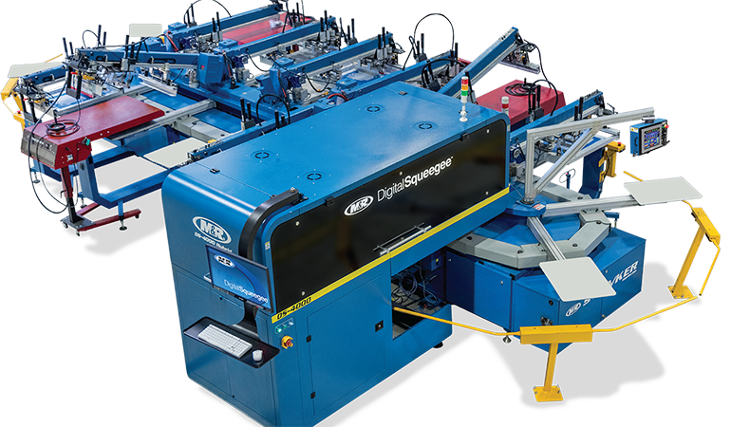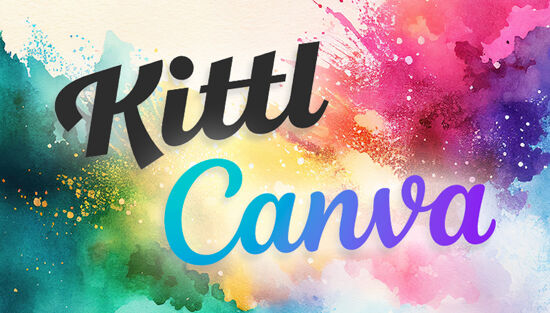Meet the Digital Squeegee

Michelle Moxley, Innovation Director at M&R Printing, explains how the Digital Squeegee and digital hybrid printing can enhance and embellish DTG work.
We are in the middle of a digital revolution in embellishment. Digital hybrid printing is a union of analogue screen printing and traditional digital direct-to garment (DTG) printing, two of the most common embellishment technologies in use today. Essentially, hybrid is an automatic screen printing press with a CMYK digital printer (or Digital Squeegee) located on one of the print stations.
Digital hybrid is a digital enhancement to screen printing. Users can decrease set-up times and achieve print consistency. Hybrid uniquely offers variable data options, creating endless customisations, such as DTG, with the added ability of screen-print specific capabilities like printing on speciality fabrics or using effects. Anything that can be screen printed can be printed using a Digital Squeegee.

What market opportunities do digital squeegees offer when combined with screen printed special effects?
With hybrid, you can incorporate special effects that you cannot with DTG alone. These special effects allow you to further distinguish your printed designs and set them apart. Within the past year, we’ve printed safety vests, transfers, polyester safety hoodies with reflective ink, coasters, and even a tortilla.
Hybrid loves special effects and we’ve printed with, or on, dozens of effects, including printing directly onto foil inline to create a unique hybrid-only application. Creativity and experimentation are two keys to standing out in the market. I encourage all shops, at no matter what level, to keep exploring and push outside their comfort zone to find new ways to serve today’s customer.

Michelle Moxley
What market trends is the Digital Squeegee tapping into?
Hybrid can print a variety of fabrics using screen-printed migration blockers that inhibit dye migration on 100% polyester and still allow for a digital print on the surface. Hybrid is versatile enough to print on any fabric that is used with traditional screen print. Screen printing set-ups involve tweaking to match customer specifications. In digital hybrid this tweaking takes seconds to update – reducing friction and offering creative exploration. This is due to less screen application with hybrid and the ability to affect the digital file then instantly print again.
Hybrid printing is up to four times faster than traditional DTG. Use of a screen printed white underbase is less than one-quarter the cost of digital white
The photo-real market has adopted the technology for print consistency across print runs or even vendors. Sport apparel has also adopted the technology to allow for lower size runs and faster set-ups, yielding higher throughput.
What is the best way to sell this technology to clients?
Exploring the full capability of the tech is key. Meeting clients where they are with the enhanced image resolution and print consistency can be a great way to start, or even faster set-ups turning to higher throughput on small order sizes. Next on the list: exploring the things that make the digital hybrid so unique, like variable data.
Variable data is a form of digital printing, including on-demand printing, in which elements such as text, graphics and images may be changed from one printed piece to the next without stopping or slowing down the printing. New business models across the market actively use social media, analytics and cloud-based management systems.
Collecting and harnessing data is important to create customisations, speed product to the market, localise the supply chain, and lower the need for excess embellished inventory. Exploring the special effect application is exciting in hybrid space because of the extent of development potential.

Where is the 'sweet spot' of this technology for clients thinking about making the switch?
DTG and screen-print have their own unique strengths, with DTG capable of printing short run quantities with minimal make-ready, while screen print offers high production speed with price competitive consumables that make it the ideal choice for high-volume production.
Digital hybrid printing brings the very best of two worlds together: it enhances screen print, utilises variable data and reduced set-ups, and creates inventory control
Additionally, hybrid, with screen print capability special effects and almost any fabric can be printed easily. Analogue screen print set-ups can be costly and time-consuming. Only high print volumes absorb the set-up cost. In today’s market, run sizes are trending smaller and smaller, requiring more efficiency to amortise set-up. Hybrid printing harnesses the strength of both print technologies to create a unique capability for short to medium volume production.
Colour calibration systems in hybrid anticipate and assign CMYK builds to reproduce a gamut of colour that includes most photo-real applications. When a colour is ‘out of gamut’, an addition of a single screen achieves the full colour range. Additional space on a press is open for special effect application. Hybrid printing is up to four times faster than traditional DTG. Use of a screen printed white underbase is less than one-quarter the cost of digital white.
With more customisation and data harnessing, digital is the answer for a fast-changing market. Digital hybrid printing brings the very best of two worlds together: it enhances screen print, utilises variable data and reduced set-ups, and creates inventory control. Hybrid improves DTG application with special effects, exact colour matching and faster production speeds.
Become a FESPA member to continue reading
To read more and access exclusive content on the Club FESPA portal, please contact your Local Association. If you are not a current member, please enquire here. If there is no FESPA Association in your country, you can join FESPA Direct. Once you become a FESPA member, you can gain access to the Club FESPA Portal.
Topics
Recent news

Regulation guidance: Corporate Sustainability Reporting Directive
The Corporate Sustainability Reporting Directive (CSRD) is now in effect, but with further changes on the horizon, what does it mean for printers? Sustainability consultant Rachel England outlines everything you need to know and talks to Apigraf about how your business may be affected.

Web-to-print design: Canva versus Kittl
We look at popular design packages Canva and Kittl to determine how they compare regarding graphic design and print on demand.

FESPA in South Africa: the print skills to thrive
Printing SA’s Career Day inspired young Cape Town learners to explore printing and packaging careers.

The rise of Chinese printers
Chinese printing companies are on the rise, and have their eyes set on the UK and EU marketplace. Some have made an instant impact; others are running into issues with maintenance and language barriers. What does the future hold for Chinese printing firms, and how can you navigate working with them?